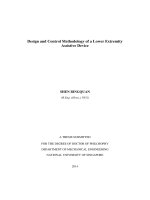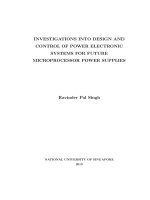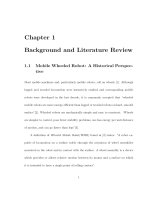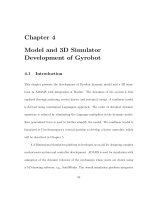Design and control methodology of a lower extremity assistive device
Bạn đang xem bản rút gọn của tài liệu. Xem và tải ngay bản đầy đủ của tài liệu tại đây (3.41 MB, 118 trang )
Design and Control Methodology of a Lower Extremity
Assistive Device
SHEN BINGQUAN
(B.Eng. (Hons.), NUS)
A THESIS SUBMITTED
FOR THE DEGREE OF DOCTOR OF PHILOSOPHY
DEPARTMENT OF MECHANICAL ENGINEERING
NATIONAL UNIVERSITY OF SINGAPORE
2014
DECLARATION
I hereby declare that the thesis is my original work and it has been written by
me in its entirety. I have duly acknowledged all the sources of information
which have been used in the thesis.
This thesis has also not been submitted for any degree in any university
previously.
_________________
Shen Bingquan
1
st
September 2014
i
Acknowledgements
I would like to thank my supervisors Assoc. Prof. Chew Chee Meng and Prof.
Poo Aun Neow for their patience, guidance and freedom during the course of
my Ph.D. study. My deepest gratitude goes to Prof. Chew Chee Meng who has
given me a chance to journey into this amazing field of robotics when he took
me into team ROPE many years back, during my undergraduate studies.
Additionally, I would like to thank my project mates, Li Jinfu, Bai Fengjun
and Tomasz Lubecki, for their dedication, assistance and support without
which this work would not have been possible.
Next, my thanks go out to Li Renjun, Loh Wenhao and Wu Ning. It has been a
pleasure to go through graduate school with their company, through all its ups
and downs.
I would also like to thank all the students and staff of Control and
Mechatronics Laboratory for their friendship and support over the past few
years. In particular, I would like to thank Albertus Hendrawan, Huang
Weiwei, Tan Boon Hwa, Syeda Mariam Ahmed, Mohan Gunasekaran, Peng
Chang, Chen Nutan, Feng Xiaobing, Chao Shuzhe, Chanaka Dilhan
Senanayake, Simon Alt, Sven Knuefer, Tshin Oi Meng, Hamidah Bte Jasman,
Ooi-Toh Chew Hoey, and Sakthiyavan s/o Kuppusamy.
I would like to thank my parents and family for their unwavering support,
assurance and understanding during my seemingly endless study.
Finally, I thank Yuan. For reminding me that there is more to life than
graduate school, for standing by me even through the bleakest days, for her
care and concern. Thank you, Yuan.
This work was supported by the Singapore Ministry of Education (MOE)
Academic Research Fund (Grant No.: R-265-000-419-112).
ii
Summary
Intensive and task-oriented gait rehabilitation has shown to improve walking
function of stroke patients. However, the access to present rehabilitation
devices is limited to tertiary rehabilitation centers due to their size and cost. In
addition, their fixed trajectory based control method limits the effectiveness of
training. This thesis attempts to address these issues, and proposes an
effective control method for intuitive assistance of an assistive device.
In this work, we present a development and control methodology of a lower
extremity assistive device for home rehabilitation and assistance in Activities
of Daily Living (ADL). To begin, a survey of recent works in the field of
lower limb exoskeleton was done. Then, a list of considerations for a
wearable assistive is discussed before a portable wearable assistive device,
called Lower Extremity Assistive Device (LEAD), is developed and
presented.
Next, we proposed and justified the need for two different assistance
controllers, namely gravity compensation and gait period based assistance, for
two different classes of motion tasks, viz.: transient and cyclic, respectively.
For the gravity compensation assistance, a method of assistance based on a
simplified human model is presented. Experiments on the LEAD found that it
could significantly reduce the muscle effort required for transient tasks. In
gait period assistance, a method of functional assistance based on gait period
recognition is investigated. The gait cycle is examined and sub-divided based
on their intend function. To determine the current gait period of the user, a
gait period detector which utilizes Gaussian Mixture Model (GMM) is
proposed. The GMM is used to characterize the probability of the user in each
of the sub-divided gait period based on the biomechanical data of the user.
Assistance is then supplied based on the intended function at each gait period.
Experimental results show that the gait period detector could effectively detect
each gait period. Moreover, experiments with the implementation of
iii
functional assistive force in conjunction with the gait period detector shows
that it could significantly reduce physical exertion during level walking.
Finally, in order to switch to the appropriate assistance mode for a given
motion task, a supervisory controller to determine the intended motion of the
user in real-time called the Motion Intent Classifier is proposed. It uses a
series of GMM classifiers and a state transition diagram to detect the user’s
motion. Results of this proposed method has been shown to be capable of
detecting and transiting between motion states accurately.
iv
To life.
v
Table of Contents
Acknowledgements i
Summary ii
Table of Contents v
List of Tables viii
List of Figures ix
Chapter 1 Introduction 1
1.1. Background and Motivation 1
1.2. Objective and Scope 3
1.3. Thesis Contribution 4
1.4. Thesis Organization 5
Chapter 2 Literature Review 6
2.1 Lower Extremity Exoskeleton Research 6
2.1.1 Rehabilitation or Mobility 6
2.1.2 Strength Augmentation 10
2.2 Classification of Control Methods 16
2.2.1 Force Amplification 17
2.2.2 Master and Slave 17
2.2.3 Gravity Compensation 18
2.2.4 EMG based 19
2.2.5 Phase of Gait 20
2.2.6 Manual Control 21
2.2.7 Others 21
2.3 Summary 21
vi
Chapter 3 Design and Development of the LEAD 23
3.1 Design Specifications 23
3.1.1 Anthropometry 23
3.1.2 Power and Torque Requirements 24
3.1.3 Kinematic Compatibility 26
3.1.4 Range of Motion 26
3.2 Final Design 27
3.2.1 Structure Overview 27
3.2.2 Electronic Architecture 29
3.3 Friction Compensation 31
3.4 Gait Kinematics with LEAD 34
3.5 Summary 35
Chapter 4 Assistance Controller 37
4.1 Gravity Compensation Assistance 38
4.1.1 Introduction 38
4.1.2 Gravity Assistance Controller 39
4.1.3 Experiments 42
4.1.4 Results and Discussions 45
4.2 Gait Phase Based Assistance 50
4.2.1 Introduction 50
4.2.2 Sub-division of Human Walking 51
4.2.3 Gait Phase Based Assistance Controller 55
4.2.4 Experiments 60
4.2.5 Results and Discussions 64
4.3 Summary 74
Chapter 5 Motion Intent Classifier 75
5.1 Introduction 75
vii
5.2 Methodology 76
5.2.1 Control Architecture 76
5.2.2 Training Data Acquisition 77
5.2.3 Signal Preprocessing and Feature Extraction 79
5.2.4 Dimension Reduction 80
5.2.5 Motion Intent Classifier using Gaussian Mixture Model (GMM)
80
5.2.6 GMM Configuration Selection 83
5.3 Results and Discussions 84
5.3.1 PCA Results for Steady State Motion 84
5.3.2 GMM Configuration Selection for Steady State Motion 85
5.3.3 Class Labeling for Transient Motion Task 87
5.3.4 GMM Configuration Selection for Transient Motion 88
5.3.5 Implementation Results 90
5.4 Summary 93
Chapter 6 Conclusion and Recommendations for Future Works 94
6.1 Summary of Contributions 94
6.2 Recommendations for Future Work 95
Bibliography 97
Author’s Publications 104
viii
List of Tables
Table 3.1: Anthropometrical Data of Singapore's Males 24
Table 3.2: Range of Motion from [55, 56, 62] 27
Table 3.3 Specifications of the LEAD (One limb) 28
Table 3.4: Fitting Parameters for Exponential Friction Model 34
Table 4.1: Value of Parameters with respect to the Height and Weight of User
40
Table 4.2: Gait Period undergone by each leg during walking and their
respective functions 52
Table 4.3: State Transition Conditions for gait period detector 58
Table 4.4: Direction of Assistive Torque of Joints for each Sub-State 59
Table 4.5: Gait Periods with their respective state label, and their respective
starting and ending percentages in a normal gait cycle 62
Table 4.6: Average transition percentages for gait period detector 67
Table 4.7: Impedance parameters 68
Table 4.8: Average and standard deviation of heart rate under different
conditions 71
Table 5.1: List of Motion Trials 77
Table 5.2: Motion State Transition Conditions 82
Table 5.3: Chosen GMM configuration for steady state motion 87
Table 5.4: Confusion matrix of classification for steady states motion 87
Table 5.5: Chosen GMM Configuration for Transient State Motion 89
Table 5.6: Confusion Matrix in all Motion Classification 90
ix
List of Figures
Figure 2.1: Non-portable exoskeleton for gait training, namely ALEX by Uni.
of Delaware, USA (left), Lokomat by Hocoma, Switzerland (Centre), and
LOPES by Uni. Of Twente, Netherlands (Right) 7
Figure 2.2: An example of impedance control architecture for Lokomat [9] 8
Figure 2.3: From Left, ReWalk by Argo Medical technologies, Israel; Esko by
Berkeley Bionics, USA; REX by Rexbionics , New Zealand; and SUBAR by
the University of Sogang, South Korea 9
Figure 2.4: Power Assist Suit developed by the Kanagawa Institute of
Technology [24] (left) and HAL 5 by Cyberdyne [25] (right) 11
Figure 2.5: The Lower Extremity Exoskeleton (LEE) from Nanyang
Technological University [29] (left) and Under-actuated exoskeleton with
passive elements, MIT Biomechatronics [30] (right) 12
Figure 2.6: XOS 1 (left) and XOS 2 (right) developed by Raytheon Sarcos,
USA [31] 13
Figure 2.7: BLEEX by University of California, Berkeley [15] (left) and
HULC by Berkeley Bionics [32] (right) 14
Figure 2.8 Honda's Stride Management Assist Device [34] (left) and Walking
Assistance Device [35] (right) 15
Figure 2.9 Control method depending on the level of autonomy in the system
16
Figure 3.1: Sagittal plane joint angles, moments and powers for the hip and
knee during level walking. Shown are average values (solid line), one standard
deviation in average value (gray band), and average foot off (vertical gray
line) taken from [55] 25
Figure 3.2: Location of sliding frame for user adjustments 27
Figure 3.3: The Lower Extremity Assistive Device (LEAD) prototype on
different users. 1: Orthotic cuffs; 2: Hip joint actuator module; 3: Knee joint
actuator module; Each module consist of, 4: Housing for DC motor and
harmonic gear; 5: Digital servo drive; 6: Incremental encoder 29
x
Figure 3.4: Placement of ground reaction force sensor 29
Figure 3.5: Electronic architecture of LEAD 30
Figure 3.6: Feedback friction compensation scheme, where
32
Figure 3.7: Frictional torque to velocity 33
Figure 3.8: Experimental setup for walking trial 34
Figure 3.9: Joint Angles for 15 gait cycles for a subject walking at 2 km/h with
the device (Blue solid lines), Normal biomechanical data for level ground
walking taken from [65] (Red dashed line) 35
Figure 4.1: Definition of system model’s parameters and variables, where 0
degrees of each joint is defined when the user is in an upright standing
posture. 40
Figure 4.2: Surface EMG electrode placement sites of respective muscles [71]
44
Figure 4.3: Sit-to-Stand task 45
Figure 4.4: Data for one of the assisted static squat trials 46
Figure 4.5: Normalized iEMG of RF and VM muscles with and without
assistance during static squats (* indicates significance difference with p <
0.05) 47
Figure 4.6: Data for one of the assisted sit-to-stand trial ( 49
Figure 4.7: Normalized iEMG of RF and VM muscles with and without
assistance during sit-to-stand 50
Figure 4.8: Normal walk cycle illustrating the events of gait [53] 52
Figure 4.9: Sagittal plane internal joint moments of hip, where extensor
moments are positive [55] 54
Figure 4.10: Sagittal plane internal joint moments of knee, where extensor
moments are positive [55] 55
Figure 4.11: Finite state machine diagram for gait phase detector 56
Figure 4.12: Output of sigmoid function implemented 60
Figure 4.13: Subject walking with LEAD. Sequential gait depicted in
clockwise direction. 61
xi
Figure 4.14: Sensor measurements from the LEAD for a normal treadmill
walking trial at 1 km/h 64
Figure 4.15: Solid line depicts the average flexion angles of Hip (top) and
Knee (bottom) normalized based on percentage gait cycle. The dotted line
shows their respective two standard deviation band. 65
Figure 4.16: Solid line depicts the average normalize GRF of Back (top), Mid
(Middle) and Front (bottom) normalized based on percentage gait cycle. The
dotted line shows their respective two standard deviation band. 65
Figure 4.17: A segment of the result of the gait period detector based of 1
km/h walking on treadmill. The top and center graphs show the angle and
GRF measurements respectively. The bottom graph depicts the output of the
Gait Phase Detector. Periods are labelled as follows, Early Stance = 1, Mid
Stance = 2, Late Stance = 3, Early Swing = 4, Mid Swing = 5 and Late Swing
= 6. 66
Figure 4.18: The estimated probability of each gait period 67
Figure 4.19: LEAD in assistance mode 69
Figure 4.20: Heart rate, in terms of beats per minute (bpm), during walking
trials under different conditions 70
Figure 4.21: The hip (blue) and knee (red) joint angle and assistive joint torque
in terms of percentage gait. All plots show 1 standard deviations in lighter
colored bands 72
Figure 4.22: Boxplots of heart rate values of 3 healthy subjects measured
under the four configurations 72
Figure 5.1: Control Architecture of the LEAD 77
Figure 5.2: Class labeling for features in transient motion class 78
Figure 5.3: State transition diagram of Motion Intent Classifier with their
corresponding state number 81
Figure 5.4: Ten-fold cross validation procedure 84
Figure 5.5: First three principle components of the reduced features data for all
states which have steady state motion 85
Figure 5.6: Evaluation score of GMM classifier for different steady state
motion under different configurations 86
xii
Figure 5.7: Steady State Motion Class Labeling for Sit to Stand Motion, where
Motion State are indexed as follows, Unclassified state = 0, Sit = 1, and Stand
= 4 88
Figure 5.8: Evaluation score of GMM classifier for transient motions under
different configurations 89
Figure 5.9: Motion Intention Classifier result for Sit and Stand Transition 91
Figure 5.10: Motion Intention Classifier results for Stand to Walk Transition
92
1
Chapter 1
Introduction
1.1. Background and Motivation
Impaired walking function is an important cause of functional disability and
morbidity after stroke, affecting nearly two thirds of stroke survivors [1]. It is
found to correlate with inpatient length of stay for both acute and
rehabilitation hospitalization [2]. Moreover, it increases the burden of care and
correlates with the rate of readmission to hospital and long-term
institutionalization [3, 4]. This also results in long term complications such as
falls, osteoporosis, contractures, depression and cardiovascular complications.
To improve walking function after stroke, mobility interventions in the form
of continuous high intensity, task-oriented rehabilitation have shown to
improve walking distance and speed of patients, particularly for those with
moderate walking deficits [5, 6]. However, conventional gait training is a
highly repetitive, labor-intensive task that requires up to three therapists to
manually assist the legs and torso of a patient performing the training. As a
result, these trainings are typically limited to 20-30 minutes for each session
due to therapist fatigue, which limits the training intensity and frequency for
patients. Furthermore, repeatability of these training sessions is also poor, as
assistance level differs between therapists.
Robotic gait trainers are seen as a solution to relieve the therapists of the
manual labor required during manual treadmill training. And in the recent
years, there has been a significant increase in research and development in the
area of lower extremity exoskeletons. Robotic gait trainers can be broadly
categorized in terms of portability, with each device being either non-portable
or portable.
2
Non-portable devices are normally designed for automated gait training on a
treadmill, such as the Auto-Ambulator [7], POGO [8], Lokomat [9, 10],
LOPES [11] and ALEX [12, 13]. They will be covered in detail in the
following chapter. In general, these devices allow gait training to be
administered to severely affected patients as they often incorporate a body-
weight support system to provide postural stability. They have been shown to
be effective in improving outcomes of gait training in stroke subjects, as
compared to conventional gait training [14]. However, access to these devices
is limited to hospitals due to their high cost, huge size and non-portability.
On the other hand, portable devices are light-weight and wearable devices. A
portable rehabilitation system which can be taken home to assist with gait
training would be advantages for stroke patients. Current portable devices
available such as the HAL [15], BLEEX [16] and Rewalk [4, 17] will be
covered in detail in the next chapter. Generally, these devices serve to
augment the user’s strength or to enable mobility for paraplegic individuals.
Apart from the technical difficulties to realize these portable devices, one of
the main challenges is the method of control as we can see in the next chapter.
It must be able to provide an assistive force that is coherent with the intended
motion of the user. Furthermore, this must be done in real-time. In addition,
not all of the existing method of control is suitable for users suffering from
stroke. At present, most of the devices move the patient through a fixed
trajectory. Hence, there is no cycle-to-cycle variation in the kinematics and
sensorimotor feedback which may impair motor learning [18]. Furthermore,
in a home-based environment, the device must allow autonomy in motion for
the user so as to assist in a range of motion commonly required for the lower
extremity during activities of daily living (ADL), such as walking and sit to
stand transfer.
Therefore, developing a portable assistive device with an effective control
method that simultaneously provides user autonomy and appropriate
assistance during gait rehabilitation and ADL remains an elusive task.
3
1.2. Objective and Scope
Based on the survey, which will be detailed in Chapter 2, numerous lower
extremity exoskeletons have been developed. However, there are still some
challenges to be resolved:
A gait training device is required, that is inexpensive, light-weight and
wearable such that more people may benefit. It would be good if the
system is portable and easy to put on and operate, such that it can be
taken home to facilitate active gait rehabilitation exercises at home.
Current control methods for these devices may not be suitable for
stroke patients. As mentioned, most commercially available device are
robot driven, meaning the device move the patient’s limb through a
fixed trajectory. As a result, the patient lacks active participation which
was found to have detrimental effects on the rehabilitation process
[18]. On the other end of the spectrum, we have control methods which
are entirely user driven, whereby the robot take up the passive role and
merely follows the user’s movement. However, these methods are
unable to provide assistance to the patient. Therefore, a control method
remains to be found, where assistance is only provide when needed.
While some commercial exoskeleton systems have demonstrated the
ability for intuitive and autonomous control of their device. To our
knowledge, their methods were not published in the literature. Thus, a
method of intention detection that can allow intuitive use of such
devices is needed.
The objectives of this research are to:
Develop a portable, light weight and wearable assistive device for the
lower limb. It should be adjustable to fit to different users and it should
be able to deliver a significant assistive torque to assist human in
motion. The user should be able to move comfortably, with minimal
4
hindrance while wearing the device. Most importantly, the device
should be safe to use with a range of motion not exceeding that of the
user’s.
Develop a control method capable of assisting in gait rehabilitations
and ADLs. The control method should allow user autonomy, and
provide torque that assist and not encumber the intended motion of the
user. It should be able to assist in a range of motion commonly
required for the lower extremity during activities of daily living
(ADL). Moreover, it should be intuitive to use such that new users
require little or no training to operate.
1.3. Thesis Contribution
The contributions of this thesis are as follows:
The development of a portable, light-weight lower extremity assistive
device.
The identification of friction parameters and implementation of a feed-
forward friction compensation for the assistive device to increase
transparency. That is, the device should not hinder the wearer’s
motion.
The establishment of a task assistance scheme with a proposed gravity
compensation scheme based on a simplified human model.
The development of a gait period detector which utilizes Gaussian
Mixture Models (GMM) to recognize the current gait period of the
user in real-time.
The establishment of walking assistance with virtual impedance-based
functional assistive force based on sub-divided gait period.
5
The development of a supervisory controller for real-time motion
intention detection to allow intuitive control of the assistive device.
1.4. Thesis Organization
This thesis is organized as follows:
Chapter 2 gives a literature review of the exoskeleton research which is
relevant to this thesis. The control strategies used by these exoskeletons are
then classified into different categories and discussed.
Chapter 3 concerns the development of a wearable assistive device. Firstly,
the considerations used in the developing process of a wearable assistive
device are discussed. Next, the finalized mechanical structure and electronic
architecture of the assistive device is presented. Lastly, a method of friction
compensation is presented and the result of implementation is shown.
Chapter 4 proposes and justifies the need for two different method of
assistance for different type of motion class, namely gravity compensated and
period of gait assistance. Detailed description for each method is presented.
And the effectiveness of each assistance method is verified by actual
experimental results.
Chapter 5 proposes an algorithm to determine the intended motion of the user
in real-time in order to switch to the appropriate assistance mode. A
comprehensive description of the proposed method is given. From the
implementation results, the feasibility and effectiveness of the proposed
method is discussed.
Chapter 6 concludes the work done in this thesis and provides
recommendations for future work.
6
Chapter 2
Literature Review
Over the last decade, there has been a significant increase in the research and
development of exoskeleton devices across the globe. An exoskeleton is
defined as an actuated device with an anthropomorphic configuration which
could be attached externally to the limbs. They are typically designed to
provide interaction forces that assist the user, be it for rehabilitation or for
strength augmentation purposes.
Since the thesis only focuses on the lower extremities, this chapter will present
the background information and a brief review of the works done in the field
of lower extremities exoskeleton research. In terms of hardware, they can be
classified according to the portability of the device, with each device being
either portable or non-portable. A comprehensive survey on portable lower-
extremity exoskeletons and active orthoses was done in [19]. The following
review serves to supplement the author with an updated survey in the field of
portable lower-extremity exoskeletons as well as to familiarize the author in
the development of non-portable lower-extremity exoskeletons which are
mainly used in gait rehabilitation. The list is not exhaustive, for the number of
assistive robots for lower extremities has grown exponentially over the last
few years. And this review will only focus on the more prominent
developments in the field.
The last section will attempt to classify and discuss the feasibility of the
various control strategies employed on these devices for our purpose.
2.1 Lower Extremity Exoskeleton Research
2.1.1 Rehabilitation or Mobility
This category of exoskeleton is designed to aid patients with lower extremity
paralysis or weakness due to spinal cord injury (SCI) or neurological disease
7
in their daily locomotion activities. While others are primarily developed for
automated gait training on a treadmill for rehabilitative purposes.
Figure 2.1: Non-portable exoskeleton for gait training, namely ALEX by Uni. of Delaware, USA (left),
Lokomat by Hocoma, Switzerland (Centre), and LOPES by Uni. Of Twente, Netherlands (Right)
Lower limb exoskeletons for rehabilitation (Fig. 2.1) are often non-portable
devices combined with a treadmill and a body-weight support system for
automated gait training. These devices are designed to allow severely impaired
patients to engage in gait therapy.
Some of the commercially available devices for this non-portable class of
exoskeleton are the Lokomat [9, 10] and Autoambulator [7]. Others devices
developed for research include the ALEX (Active Leg EXoskeleton) [12],
POGO (Pneumatically Operated Gait Orthosis) [8] and LOPES (Lower
Extremity Powered Exoskeleton) [11]. These devices will be reviewed shortly
with the exception of the Autoambulator as no scientific publication could be
found on this device according to our knowledge.
The Lokomat, developed by Hocoma, consist of a body weight support system
with an exoskeleton with actuation at the hip and knee joints in the sagittal
plane. The ankles are held up by passive straps to prevent them from hitting
the ground during swing. During gait training, the patient is generally made to
follow a predetermined gait trajectory repetitively. Thus, in earlier version of
Lokomat, the patient limbs are forced to strictly follow the predetermined path
under position control and the human will have little influence over the
trajectory of the exoskeleton. However, a robot driven patient will not
experience cycle-to-cycle variation in the kinematics and sensorimotor
8
feedback. This may cause habituation to sensory input, reduce sensory
responses to weight-bearing locomotion and ultimately impair motor learning
[18]. Therefore, newer generation of Lokomat, and other rehabilitation robots,
aim to achieve an Assist-As-Needed (AAN) system. Later generations of
Lokomat implemented impedance control [20], as depicted in Fig. 2.2, in
order to realize an AAN control scheme [9]. It is done with the help of
multiple force sensors at user attachment points to detect the interaction forces
between the user and the Lokomat.
Figure 2.2: An example of impedance control architecture for Lokomat [9]
The ALEX is developed by the University of Delaware. ALEX’s hardware
closely resembles that of the Lokomat, with the exception of force sensor at
every actuated joint for the ALEX. This enables the ALEX to perform force
control at the joint level. To achieve the ANN paradigm, it utilizes a force
field method to create the virtual tunnel to guide the patient’s gait trajectory to
follow a predetermined gait pattern rather than enforcing the patient to strictly
follow the path. This ‘softer’ approach encourages more patient cooperation
during rehabilitation, and improvement have been observed in stroke patients
who had participated in their gait training studies [21].
The major difference of the POGO and LOPES as compared to the Lokomat
and ALEX is that they incorporated compliant actuators into their joint design
with low intrinsic impedance in order to enhance their force tracking
performance and safety in human-robot interaction. In the modulation of the
robot’s impedance using feedback from force sensors, there is a limit to the
amount of inertia reduction which can be achieved without the risk of coupled
9
instability [22]. The residual inertia may create large interaction forces
between the human and the robot which will affect dynamic gait motion. The
POGO utilizes pneumatic actuators to actuate the hip and knee in flexion and
extension. On the other hand, the LOPES uses Series Elastic Actuators (SEA),
a concept first introduced in [23], to enhance back-drivability of the system
whereby the desired impedance of the system is set to zero for the subject to
move with minimal hindrance from the robot. Electromyography (EMG)
measurements of a subject on eight leg muscles showed that free walking in
the LOPES closely resembles that of free treadmill walking [11]. This
indicates that the impedance of the LOPES is sufficiently low to not adversely
change the gait pattern of an individual attached to the device.
Figure 2.3: From Left, ReWalk by Argo Medical technologies, Israel; Esko by Berkeley Bionics, USA;
REX by Rexbionics , New Zealand; and SUBAR by the University of Sogang, South Korea
Lower limb exoskeleton for mobility (Fig. 2.3) is generally built to aid
disabled patients or those suffering from general weakness, namely
paraplegics and the elderly, to go about and perform their daily walking
activities.
The main objective of the Rewalk [4, 17] developed by Argo Medical
Technologies, Israel, , the Vanderbilt exoskeleton [24] by Vanderbilt
University, USA and the Esko [14] by Berkeley Bionics which is now known
as Esko Bionics, USA, is to enable paraplegic users to walk again. The user
balances through the use of crutches. Using an array of the sensors
information from the exoskeleton itself and the crutches, the device estimates
10
the user’s intention and executes the gait pattern stored for the particular mode
of operation (such as walking, stairs-climbing and sitting). However, the
method of user’s intention detection is not known to the public since they are
commercial products. Rewalk uses highly geared DC motors to actuate the hip
and the knee joints, while ESKO uses hydraulic actuation on similar joints.
REX [15] developed by Rexbonics in New Zealand, allows the paraplegic user
to stand and walk without the use of crutches or other supports. User
commands the motion of the exoskeleton using a joystick, and REX executes a
gait trajectory in that direction. A balancing algorithm ensures that the device
and the patient remain stable during the entire motion. However, as it is a
commercial device, the method of balancing is not made public.
The SUBAR (Sogang University Biomedical Assistive Robot) [25] developed
by the University of Sogang, South Korea, is designed for assisting people
with severe impairments. It uses a rotary SEA to generate sufficiently high
torque at low levels of impedance. It has exhibit good force tracking
performance, but higher level algorithms to determine assistive torques are
still under development as of 2013.
2.1.2 Strength Augmentation
This class of exoskeletons is commonly portable device which assists the user
by augmenting the joint torque and work to complete a specific task, e.g. stairs
ascend. They can be used with patients with weaken legs, like the elderly, or
on healthy individuals to increase their performance in terms of strength or
stamina.
11
Figure 2.4: Power Assist Suit developed by the Kanagawa Institute of Technology [26] (left) and HAL 5
by Cyberdyne [27] (right)
One such exoskeleton design is the Power Assist Suit (Fig. 2.4) developed by
the Kanagawa Institute of Technology. It is developed to aid nursing personnel
in carrying patients by providing assistive torque at the elbow, waist and knee
joints. The user intended torque is measured by a novel muscle hardness
sensor. The assistive torque is derived from the intended torque, which is then
given to the joint by regulating the pressure of the pneumatic actuators [26].
The Hybrid Assistive Leg (HAL) jointly developed by the University of
Tsukuba and Cyberdyne (Fig. 2.4) to aid elderly or weaken patient to walk. It
has also demonstrated the capability to increase the strength of an abled-body
individual. The HAL uses DC motor with harmonic drive to power the
movement of the hip and knee joints. For control, the HAL system uses skin-
surface electromyography (EMG) signals and joint encoders to determine the
intended user’s torque. The EMG readings of the antagonistic muscles across
a joint and the kinematic information of the user’s limb are fed into a muscle
model of the particular user to generate the estimated torque [28]. Parameters
of the muscle model have to be predetermined over multiple trials which
would take extended period of time. Hence, HAL reportedly needs 2 months
to be optimally calibrated for an individual [27]. In the recent years, some
research efforts towards intent based detection using the user’s kinetic and
kinematic information have been made. HAL utilizes a phase sequence
approach which assumes sequential motion of the user and infers the transition









